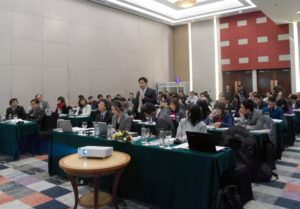
A number of organizations have noted one of the primary challenges of implementing energy efficiency programs for Vietnam's building sector is the lack of technical skills regarding energy efficiency and lack of knowledge of systematic energy management in enterprises and large buildings. The International Partnership on Mitigation and MRV, United Nations Environment Programme, and others have provided in depth analysis to this end and sources are attached. Meanwhile, the Pacific Northwest National Laboratory, part of the U.S. Department of Energy has propsosed a training plan targetting building energy efficiency in Vietnam.
PNNL Proposal
Vietnam has experienced fast growth in energy consumption in the past decade, with annual growth rate of over 12 percent. This is accompanied by the fast increase in commercial energy use, driven by rapid industrialization, expansion of motorized transport, and increasing energy use in residential and commercial buildings. Meanwhile, Vietnam is experiencing rapid urbanization at a rate of 3.4 percent per year; and the majority of the growth centered in and near major cities such as Hanoi and Ho Chi Minh City. This has resulted in a construction boom in Vietnam.
In response to the building sector’s growth, the Government of Vietnam introduced a decree on energy efficiency in 2003 in an effort to define energy conservation, particularly in building construction, and this resulted in the development of building energy efficiency code in 2003. However, the 2003 energy efficiency building code, which was updated in 2005, was not widely implemented. The Government of Vietnam is currently updating and modifying the code for broad implementation. Given limited capacity in building energy efficiency in Vietnam, there is a need for significant efforts to train stakeholders and build capacity for the implementation of the energy efficiency building code.
This proposed training plan is based on the review of the 2011 Vietnamese Energy Efficiency Building Code (VEEBC) and international experience in developing and conducting training programs on building energy efficiency. The proposed training plan is aligned with the planned implementation set-up in Vietnam, based on the discussion with the Ministry of Construction and various stakeholders. It includes training plans and mechanisms for both short-term and long-term. Developing a discrete training gap analysis and plan could flesh out the ideas of the Ministry of Construction on training and ensure a strong foundation for future energy efficiency improvements.
| Level | Purpose (listed by priorities) | Potential Trainer | Attendee | Topic |
|---|---|---|---|---|
| Level I: Introductory training | Raise awareness of stakeholders with introductory trainings of VEEBC | VACEE | MOC, other Ministries, provincial and local officials, code officials and inspectors, developers, utilities, architects, engineers, universities, other professionals | Introductory Training on VEEBC Codes 101; enforcement structure; codes specifications (scope and application) |
| Level II: Compliance check | Enable inspectors and/or code officials to conduct plan review and inspection and evaluate code compliance | MOC, VACEE | Code officials, third-party inspectors (if using third-party inspectors) | Compliance Check for VEEBC Codes 101; compliance check (plan review and pre-inspection, construction inspection provisions, air leakage, commissioning, onsite changes, fill out form/use software) |
| Level II: Technical specifications | Train design professionals on specific technical issues and how to design in compliance with VEEBC | VACEE, VAA, universities, private companies | architects | VEEBC Technical Specifications (Design) Codes 101; codes specifications (envelope, scope and application); compliance check (onsite changes, fill out form/use software) |
| Train engineers on relevant technical issues and how to design in compliance with VEEBC | VACEE, universities | Engineers | VEEBC Technical Specifications (Engineering) Codes 101; codes specifications (HVAC, power and lighting, scope and application); energy simulation; OTTV calculation |
|
| Let builders be familiar with energy efficiency materials and construction, and ensure correct installation of EE technologies in buildings | Building Science and Technology Institute | Builders | VEEBC Technical Specifications (Construction) Codes 101, installation of energy efficiency materials and technologies |
|
| Level III: Training on post-occupancy energy management and audit | Train professionals for energy management, operation, and maintenance in the existing buildings | Energy Conservation Centers at the provincial level, private organizations | Engineers, technicians, architects, facility, maintenance and energy managers | Energy management, Building operation and maintenance Building energy use, glazing, insulation, building envelope, cooling, HVAC, controls, indoor air quality, electrical system, energy auditing, building commissioning, maintenance and related codes |
| Be familiar with building energy use and energy audit, determine energy saving measures used in buildings | Energy Conservation Centers at the provincial level, private organizations | Energy auditors | Energy audit Principles of energy, energy and building shell, energy auditing, air leakage, insulation, windows and doors, cooling systems, indoor air quality, lighting and appliances, and water heating |
|
| Level IV: Long-term educational training | Educate students and young professionals about building energy codes and how to perform according to the codes | Universities | university students, young engineers and architects | Building Energy Codes Training for Young Professionals Codes 101; codes specifications (envelope, HVAC, power and lighting, scope and application), simulation |
| Understand principles of energy simulation and how to use energy simulation to comply with energy codes and other green building standards | VACEE, universities | Engineers, university students | Energy Simulation Principles of building energy simulation, uncertainty in energy modeling, how to use simulation to show code compliance |
|
| Level V: Green building | Gain concrete understanding of the research that supports the costs and benefits of green building and build enough knowledge to apply sustainable design in practice | VAA, VGBC | Architects, engineers, contractors, tenant and developers, project managers, building professionals, resource conservation specialists | Sustainable design Key practices and cases of sustainable building, LEED, Lotus and other relevant criteria or established guidelines, costs and benefits of incorporating sustainable building measures, financial incentives and technical assistance offered by governments, utilities, and other organizations, guidance for education and training of staff in sustainable building. |